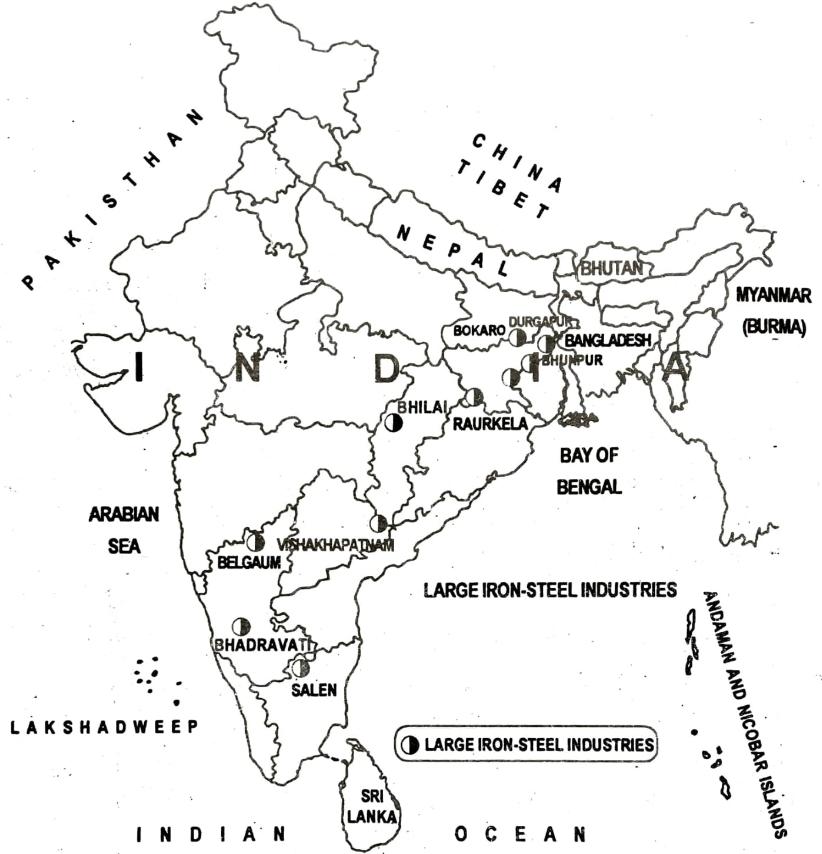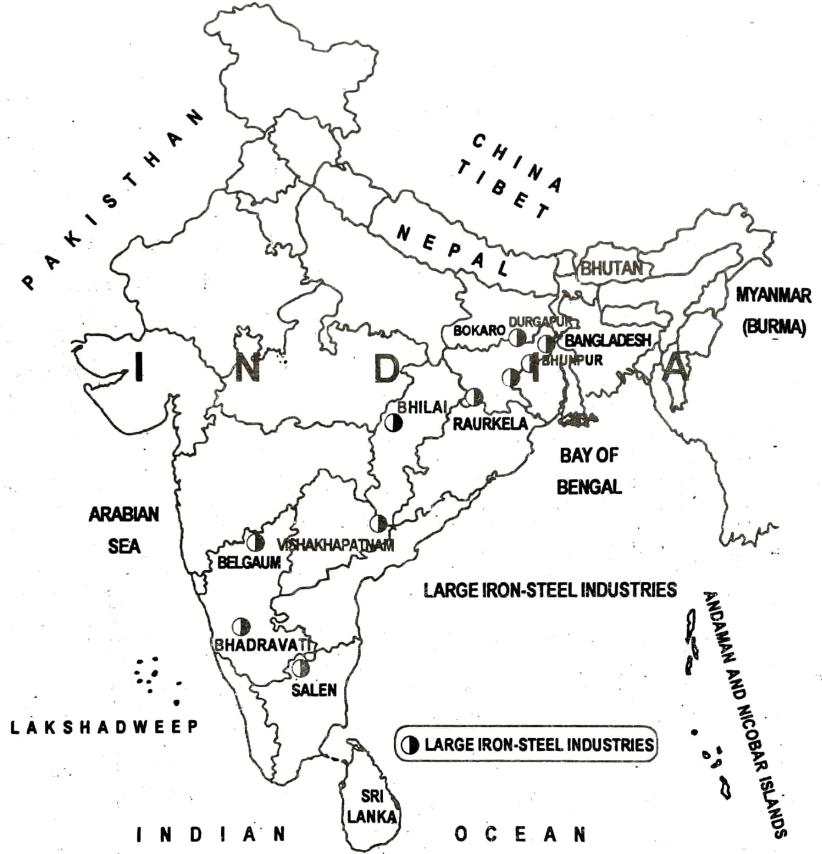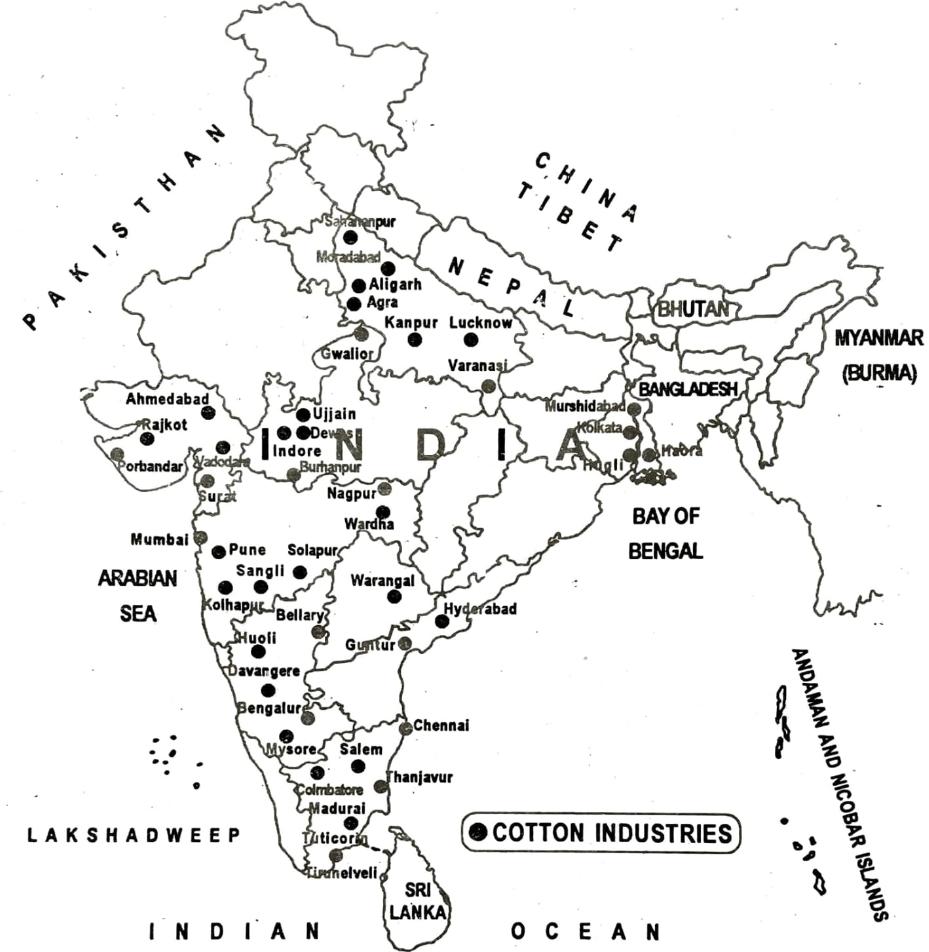Class 9 Geography Chapter 8 – Industry Complete Solutions | Assam Board (ASSEB) | Latest Syllabus | English Medium
Class 9 Geography Chapter 8 – Industry Complete Solutions (Assam Board – ASSEB – English Medium)
This chapter focuses on industries as a key secondary economic activity. It explains how raw materials are converted into finished products of higher value and covers the classification of industries based on raw materials, size, and ownership. The solutions provided will help students understand the factors affecting the location of industries and the industrial system.
✅ What you will learn:
- The concept of industry as a secondary activity
- Classification of industries (e.g., agro-based, mineral-based, marine-based)
- Industries classified by size (small-scale and large-scale)
- Factors affecting the location of industries
- The industrial system: inputs, processes, and outputs
🎯 Why choose Ospin Academy?
- Comprehensive solutions based on the latest Assam Board (ASSEB) syllabus
- Simple and clear English explanations for all concepts
- Practice questions and detailed answers for exam success
- Systematically structured content for easy learning
- A trusted digital platform for Class 9 Geography students
Class 9 Geography Elective English Medium | Latest Syllabus Chapter-wise Solutions PDF
Limited Time Offer!
(For Class 9 Geography Elective, English Medium)
Prepare thoroughly for Class 9 Geography Elective with this chapter-wise solutions PDF.
Includes complete, clear, and exam-focused textual solutions as per the latest syllabus.
Ideal for self-study, homework help, and last-minute revision.
Chapter-8
Industry
1. Classify industries stating the basis of your classification.
Answer: Systematic production involving division of labour, large investments, and the use of machines, tools, and power is known as an industry. Industries are classified on various bases as follows:
(a) On the basis of the size of establishment:
(i) Household or cottage industries: These are small industries managed by family members and produce goods mainly for local use.
Examples: Khadi, handloom, brassware, pottery, cane and bamboo work, beekeeping, leather work, carpentry, artificial flower-making, etc.
(ii) Small-scale industries: Industries with an investment of less than ₹1 crore and employing a limited number of people are termed small-scale industries.
Examples: Cane and bamboo craft, handloom weaving, toy-making, etc.
(iii) Large-scale industries: Industries that involve heavy investment in plants and machinery and employ a large number of workers.
Examples: Iron and steel industry, cotton textile industry, ship-building industry, etc.
(b) On the basis of raw materials used:
(i) Agro-based industries: Use agricultural products as raw materials to produce processed goods.
Examples: Sugar, jute, tea, and cotton textile industries.
(ii) Mineral-based industries: Use minerals like iron ore, copper, manganese, coal, and petroleum as raw materials.
Examples: Iron and steel, aluminium, copper, and petroleum industries.
(iii) Forest-based industries: Depend on forest products for raw materials.
Examples: Paper, match, furniture, and plywood industries.
(iv) Animal-based industries: Use animal products such as milk, meat, and hides for production.
Examples: Dairy, leather, and meat-processing industries.
(c) On the basis of products produced:
(i) Basic industries: Provide raw materials or goods on which other industries depend.
Examples: Iron and steel, oil, and cement industries.
(ii) Consumer goods industries: Produce finished goods directly used by consumers.
Examples: Cosmetics, radio, television, and garment industries.
(d) On the basis of ownership:
(i) Public sector industries: Owned and managed by the government with the aim of promoting social welfare.
Examples: Defence, space research, and nuclear industries.
(ii) Private sector industries: Owned and managed by private entrepreneurs or investors.
Examples: Cement, steel, and oil industries.
(iii) Co-operative sector industries: Managed by co-operative societies formed by groups of people with shared interests.
Examples: Mother Dairy, sugar mills, and co-operative spinning mills.
2. What is a household industry? What kind of goods is produced by this industry?
Answer: The industry run by family members at home, using simple tools and local raw materials, and producing goods mainly for local markets is known as a household industry.
Characteristics:
(i) Small in scale and managed by family members.
(ii) Uses local raw materials and traditional methods of production.
(iii) Goods are mostly sold in the local market.
Main products: Pottery items, handloom cloth, metallic utensils, bamboo and cane products, wooden furniture, ornaments, and similar handcrafted goods.
3. Present a comparative discussion on small-scale and large-scale industries.
Answer: A comparative discussion on large-scale industries and small-scale industries is as follows:
|
Sl. No. |
Basis of Difference |
Large-scale Industries |
|---|---|---|
|
Meaning |
Industries employing a large number of people and have huge investment in plants and machineries. |
Industries having an investment of less than rupees one crore, employing few people and have small machines to make products. |
|
Technology |
Are mostly technology-based |
Uses simple technology |
|
Uses |
Uses raw materials from the local area. |
Uses raw materials from local as well as outside area. |
|
Objective |
Bring about rapid industrialisation and prominent in developed countries. |
Promote the industrial development of a particular region mostly in developing and underdeveloped countries. |
|
National Income |
Contribution to national income is much higher. |
Contribution to national income is lower. |
|
Examples |
Iron and steel industries, cotton textile industries, ship-building industries, etc. |
Handloom industries, toy-making industries, etc. |
4. Define agro-based industry with examples.
Answer: Industries that primarily use agricultural raw materials for manufacturing and processing goods in factories are known as agro-based industries. These industries convert agricultural produce into consumable or industrial products using mechanical and industrial processes.
Examples: Sugar industry, jute industry, tea industry, coffee industry, and edible oil industry.
5. Give a brief idea of mineral-based industry.
Answer: Industries that rely mainly on minerals as their raw materials for manufacturing are known as mineral-based industries. These industries are usually located in or near areas rich in mineral resources. However, with the development of modern transport systems, many such industries are now found far from the actual mining areas.
Examples: Iron and steel industry, aluminium industry, copper industry, and oil refining industry.
6. What do you mean by basic industry? Give examples.
Answer: The industries that serve as the foundation for the operation and growth of other industries are called basic industries. They produce raw materials, tools, or components that are essential for other industries to function.
Examples: Iron and steel industry, and oil industry, which supply materials for machinery and equipment manufacturing.
7. Give an outline of the factors determining the localisation of industry.
Answer: The concentration of different industries in a particular area or region due to favourable economic conditions is known as localisation of industries. The major factors that influence the localisation of industries are as follows:
(i) Nearness to raw materials: Industries generally develop close to the sources of raw materials to reduce high transportation costs. For instance, iron and steel industries are found near iron-ore and coal deposits. Similarly, cotton textile industries are mainly concentrated in the Maharashtra-Gujarat region.
(ii) Availability of power: Industries are usually located near thermal power stations and hydroelectric plants to ensure an uninterrupted power supply and to reduce production costs. Locations close to power houses often attract industrial growth.
(iii) Efficient transport facilities: Industries tend to grow near areas with well-developed networks of roads, railways, airways, and ports. The growth of the textile industry in the Mumbai region, for example, is partly due to the presence of excellent transport infrastructure.
(iv) Availability of labour: The presence of skilled and unskilled labour encourages industrial development. Bangalore has emerged as a hub for computer-related industries due to its supply of skilled manpower. Similarly, the abundance of cheap labour has contributed to the growth of the iron and steel industries in Bihar, Jharkhand, and Orissa, and the sugar industry in Uttar Pradesh.
(v) Nearness to markets: Industries are often established near urban and commercial centres that provide a large market for their products. The textile industry flourished in the Maharashtra-Gujarat belt due to the vast local market and the convenience of exporting goods through the Mumbai port.
(vi) Climate: The climatic conditions of a region influence the establishment of certain industries. For example, cotton textile industries developed in western India due to its humid climate. Likewise, the favourable climate has supported the growth of the sugar industry in Uttar Pradesh, the woollen industry in Punjab, and the jute industry in West Bengal.
8. Write with examples about the role of raw materials in the location of industries.
Answer: The availability of raw materials near the site of production is one of the most significant factors determining the location of industries. Industries often develop close to the sources of raw materials to minimize the cost of transporting them to factories. This is why the textile industry is concentrated in Maharashtra and Gujarat, while the iron and steel industry flourished in Jharkhand, Bihar, Chhattisgarh, and Orissa, which have abundant iron-ore and coal reserves. Similarly, the jute industry is mainly found in West Bengal as it is the largest supplier of raw jute in India. The sugar industry is concentrated in Uttar Pradesh due to its major production of sugarcane. Since sugarcane is a perishable raw material that cannot be transported over long distances without spoilage, sugar mills are located close to sugarcane-producing regions. Hence, it is evident that the proximity and availability of raw materials play a decisive role in the localisation of industries.
9. Write briefly on the iron and steel industry of India.
Answer: The iron and steel sector is considered the most fundamental and vital industry in India. The industry’s true beginnings can be traced to the establishment of a steel plant at Jamshedpur by Jamshed Tata in 1907. After independence, numerous steel plants were constructed in different regions of the country. Today, the main centres of iron and steel production are concentrated in the major mineral-rich states such as Bihar, Jharkhand, West Bengal, Orissa, Chhattisgarh, Karnataka, and Tamil Nadu. At present, the industry includes both private and public sector steel plants. Among the private sector, notable plants exist at Jamshedpur (Bihar), Burnpur (West Bengal), and Bhadravati (Karnataka). Major government-owned (public sector) steel plants are located in Bhilai (Madhya Pradesh), Rourkela (Orissa), Bokaro (Bihar), and Durgapur (West Bengal). Iron and steel manufacturing is also concentrated in Asansol and Salem. This industry has a significant impact on India’s economic progress. The rapid expansion of the Indian iron and steel industry can be attributed to:
(i) Large reserves of iron ore in states like Bihar, Jharkhand, and Orissa
(ii) Availability of inexpensive labour
(iii) A vast domestic market
(iv) Supportive government policies
(v) Ready access to power near iron ore sources

10. Give an account of the cotton textile industry of India.
Answer: Cotton textile industry is one of the oldest industries of India. Today, it is one of the key industries of India. It consists of three sectors, namely:
(i) mill sector
(ii) powerloom sector
(iii) handloom sector.
The cotton textile industry has a significant role in the Indian economy and profoundly contributes to its all-round growth.
The main centres of cotton textile industries are located in Gujarat and Maharashtra. This is chiefly due to availability of raw-materials, cheap power, nearness to the Mumbai and Kandla ports, excellent network of roads and railways and climate. It is also produced in different parts of the country as well. The chief cotton textile producing areas are Maharashtra, Gujarat, Madhya Pradesh, Uttar Pradesh, Karnataka, Tamil Nadu, Andhra Pradesh and West Bengal.

11. Draw a map of India and locate thereon three iron and steel industries and the three cotton textile industries.
Answer: Self Task
12. What kind of household industries are there in your village or nearby villages or towns? Where from do the industries collect necessary raw material? Mention where the products are marketed.
Answer: Self Task
Class 9 Geography Chapter 8 – Frequently Asked Questions
Get Free NCERT PDFs
If you want to download free PDFs of any chapter, click the link below and join our WhatsApp group:
Chapter-8
Industry
1. Classify industries stating the basis of your classification.
Answer: Systematic production involving division of labour, large investments, and the use of machines, tools, and power is known as an industry. Industries are classified on various bases as follows:
(a) On the basis of the size of establishment:
(i) Household or cottage industries: These are small industries managed by family members and produce goods mainly for local use.
Examples: Khadi, handloom, brassware, pottery, cane and bamboo work, beekeeping, leather work, carpentry, artificial flower-making, etc.
(ii) Small-scale industries: Industries with an investment of less than ₹1 crore and employing a limited number of people are termed small-scale industries.
Examples: Cane and bamboo craft, handloom weaving, toy-making, etc.
(iii) Large-scale industries: Industries that involve heavy investment in plants and machinery and employ a large number of workers.
Examples: Iron and steel industry, cotton textile industry, ship-building industry, etc.
(b) On the basis of raw materials used:
(i) Agro-based industries: Use agricultural products as raw materials to produce processed goods.
Examples: Sugar, jute, tea, and cotton textile industries.
(ii) Mineral-based industries: Use minerals like iron ore, copper, manganese, coal, and petroleum as raw materials.
Examples: Iron and steel, aluminium, copper, and petroleum industries.
(iii) Forest-based industries: Depend on forest products for raw materials.
Examples: Paper, match, furniture, and plywood industries.
(iv) Animal-based industries: Use animal products such as milk, meat, and hides for production.
Examples: Dairy, leather, and meat-processing industries.
(c) On the basis of products produced:
(i) Basic industries: Provide raw materials or goods on which other industries depend.
Examples: Iron and steel, oil, and cement industries.
(ii) Consumer goods industries: Produce finished goods directly used by consumers.
Examples: Cosmetics, radio, television, and garment industries.
(d) On the basis of ownership:
(i) Public sector industries: Owned and managed by the government with the aim of promoting social welfare.
Examples: Defence, space research, and nuclear industries.
(ii) Private sector industries: Owned and managed by private entrepreneurs or investors.
Examples: Cement, steel, and oil industries.
(iii) Co-operative sector industries: Managed by co-operative societies formed by groups of people with shared interests.
Examples: Mother Dairy, sugar mills, and co-operative spinning mills.
2. What is a household industry? What kind of goods is produced by this industry?
Answer: The industry run by family members at home, using simple tools and local raw materials, and producing goods mainly for local markets is known as a household industry.
Characteristics:
(i) Small in scale and managed by family members.
(ii) Uses local raw materials and traditional methods of production.
(iii) Goods are mostly sold in the local market.
Main products: Pottery items, handloom cloth, metallic utensils, bamboo and cane products, wooden furniture, ornaments, and similar handcrafted goods.
3. Present a comparative discussion on small-scale and large-scale industries.
Answer: A comparative discussion on large-scale industries and small-scale industries is as follows:
Sl. No. | Basis of Difference | Large-scale Industries |
|---|---|---|
Meaning | Industries employing a large number of people and have huge investment in plants and machineries. | Industries having an investment of less than rupees one crore, employing few people and have small machines to make products. |
Technology | Are mostly technology-based | Uses simple technology |
Uses | Uses raw materials from the local area. | Uses raw materials from local as well as outside area. |
Objective | Bring about rapid industrialisation and prominent in developed countries. | Promote the industrial development of a particular region mostly in developing and underdeveloped countries. |
National Income | Contribution to national income is much higher. | Contribution to national income is lower. |
Examples | Iron and steel industries, cotton textile industries, ship-building industries, etc. | Handloom industries, toy-making industries, etc. |
4. Define agro-based industry with examples.
Answer: Industries that primarily use agricultural raw materials for manufacturing and processing goods in factories are known as agro-based industries. These industries convert agricultural produce into consumable or industrial products using mechanical and industrial processes.
Examples: Sugar industry, jute industry, tea industry, coffee industry, and edible oil industry.
5. Give a brief idea of mineral-based industry.
Answer: Industries that rely mainly on minerals as their raw materials for manufacturing are known as mineral-based industries. These industries are usually located in or near areas rich in mineral resources. However, with the development of modern transport systems, many such industries are now found far from the actual mining areas.
Examples: Iron and steel industry, aluminium industry, copper industry, and oil refining industry.
6. What do you mean by basic industry? Give examples.
Answer: The industries that serve as the foundation for the operation and growth of other industries are called basic industries. They produce raw materials, tools, or components that are essential for other industries to function.
Examples: Iron and steel industry, and oil industry, which supply materials for machinery and equipment manufacturing.
7. Give an outline of the factors determining the localisation of industry.
Answer: The concentration of different industries in a particular area or region due to favourable economic conditions is known as localisation of industries. The major factors that influence the localisation of industries are as follows:
(i) Nearness to raw materials: Industries generally develop close to the sources of raw materials to reduce high transportation costs. For instance, iron and steel industries are found near iron-ore and coal deposits. Similarly, cotton textile industries are mainly concentrated in the Maharashtra-Gujarat region.
(ii) Availability of power: Industries are usually located near thermal power stations and hydroelectric plants to ensure an uninterrupted power supply and to reduce production costs. Locations close to power houses often attract industrial growth.
(iii) Efficient transport facilities: Industries tend to grow near areas with well-developed networks of roads, railways, airways, and ports. The growth of the textile industry in the Mumbai region, for example, is partly due to the presence of excellent transport infrastructure.
(iv) Availability of labour: The presence of skilled and unskilled labour encourages industrial development. Bangalore has emerged as a hub for computer-related industries due to its supply of skilled manpower. Similarly, the abundance of cheap labour has contributed to the growth of the iron and steel industries in Bihar, Jharkhand, and Orissa, and the sugar industry in Uttar Pradesh.
(v) Nearness to markets: Industries are often established near urban and commercial centres that provide a large market for their products. The textile industry flourished in the Maharashtra-Gujarat belt due to the vast local market and the convenience of exporting goods through the Mumbai port.
(vi) Climate: The climatic conditions of a region influence the establishment of certain industries. For example, cotton textile industries developed in western India due to its humid climate. Likewise, the favourable climate has supported the growth of the sugar industry in Uttar Pradesh, the woollen industry in Punjab, and the jute industry in West Bengal.
8. Write with examples about the role of raw materials in the location of industries.
Answer: The availability of raw materials near the site of production is one of the most significant factors determining the location of industries. Industries often develop close to the sources of raw materials to minimize the cost of transporting them to factories. This is why the textile industry is concentrated in Maharashtra and Gujarat, while the iron and steel industry flourished in Jharkhand, Bihar, Chhattisgarh, and Orissa, which have abundant iron-ore and coal reserves. Similarly, the jute industry is mainly found in West Bengal as it is the largest supplier of raw jute in India. The sugar industry is concentrated in Uttar Pradesh due to its major production of sugarcane. Since sugarcane is a perishable raw material that cannot be transported over long distances without spoilage, sugar mills are located close to sugarcane-producing regions. Hence, it is evident that the proximity and availability of raw materials play a decisive role in the localisation of industries.
9. Write briefly on the iron and steel industry of India.
Answer: The iron and steel sector is considered the most fundamental and vital industry in India. The industry’s true beginnings can be traced to the establishment of a steel plant at Jamshedpur by Jamshed Tata in 1907. After independence, numerous steel plants were constructed in different regions of the country. Today, the main centres of iron and steel production are concentrated in the major mineral-rich states such as Bihar, Jharkhand, West Bengal, Orissa, Chhattisgarh, Karnataka, and Tamil Nadu. At present, the industry includes both private and public sector steel plants. Among the private sector, notable plants exist at Jamshedpur (Bihar), Burnpur (West Bengal), and Bhadravati (Karnataka). Major government-owned (public sector) steel plants are located in Bhilai (Madhya Pradesh), Rourkela (Orissa), Bokaro (Bihar), and Durgapur (West Bengal). Iron and steel manufacturing is also concentrated in Asansol and Salem. This industry has a significant impact on India’s economic progress. The rapid expansion of the Indian iron and steel industry can be attributed to:
(i) Large reserves of iron ore in states like Bihar, Jharkhand, and Orissa
(ii) Availability of inexpensive labour
(iii) A vast domestic market
(iv) Supportive government policies
(v) Ready access to power near iron ore sources

10. Give an account of the cotton textile industry of India.
Answer: Cotton textile industry is one of the oldest industries of India. Today, it is one of the key industries of India. It consists of three sectors, namely:
(i) mill sector
(ii) powerloom sector
(iii) handloom sector.
The cotton textile industry has a significant role in the Indian economy and profoundly contributes to its all-round growth.
The main centres of cotton textile industries are located in Gujarat and Maharashtra. This is chiefly due to availability of raw-materials, cheap power, nearness to the Mumbai and Kandla ports, excellent network of roads and railways and climate. It is also produced in different parts of the country as well. The chief cotton textile producing areas are Maharashtra, Gujarat, Madhya Pradesh, Uttar Pradesh, Karnataka, Tamil Nadu, Andhra Pradesh and West Bengal.

11. Draw a map of India and locate thereon three iron and steel industries and the three cotton textile industries.
Answer: Self Task
12. What kind of household industries are there in your village or nearby villages or towns? Where from do the industries collect necessary raw material? Mention where the products are marketed.
Answer: Self Task




